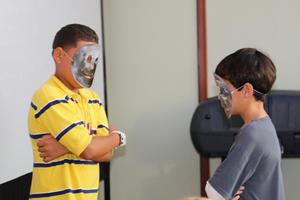Glossary term: Month
Description: In general terms a month is an interval of time that is linked to the Moon’s motion around Earth. There are different types of months, and each is linked to different aspects of the Moon’s orbit and its motion on the celestial sphere. The various types of months include synodic (based on the cycle of phases); sidereal (based on relative position to the stars); anomalistic (based on the apparent size, which is related to the elliptical orbit of the Moon, and therefore its distance from Earth); and draconic (based on the Moon’s motion on the celestial sphere). Each of these months has a different time period varying between 27 and 29 days. Calendars of various cultures around the world are aligned to the various types of months, and the religious festivals mark various cycles of the Moon.
Related Terms:
See this term in other languages
Term and definition status: This term and its definition have been approved by a research astronomer and a teacher
The OAE Multilingual Glossary is a project of the IAU Office of Astronomy for Education (OAE) in collaboration with the IAU Office of Astronomy Outreach (OAO). The terms and definitions were chosen, written and reviewed by a collective effort from the OAE, the OAE Centers and Nodes, the OAE National Astronomy Education Coordinators (NAECs) and other volunteers. You can find a full list of credits here. All glossary terms and their definitions are released under a Creative Commons CC BY-4.0 license and should be credited to "IAU OAE".
If you notice a factual error in this glossary definition then please get in touch.
Related Activities
Lunar Day
astroEDU educational activity (links to astroEDU website) Description: Through a fun-learning activity, understand why moon always keeps the same face towards Earth.
License: CC-BY-4.0 Creative Commons Attribution 4.0 International (CC BY 4.0) icons
Tags:
Lunar day
Age Ranges:
4-6
, 6-8
Education Level:
Primary
, Secondary
Areas of Learning:
Modelling
, Structured-inquiry learning
Costs:
Free
Duration:
30 mins
Group Size:
Group
Skills:
Analysing and interpreting data
, Asking questions
, Communicating information
, Constructing explanations
, Developing and using models









